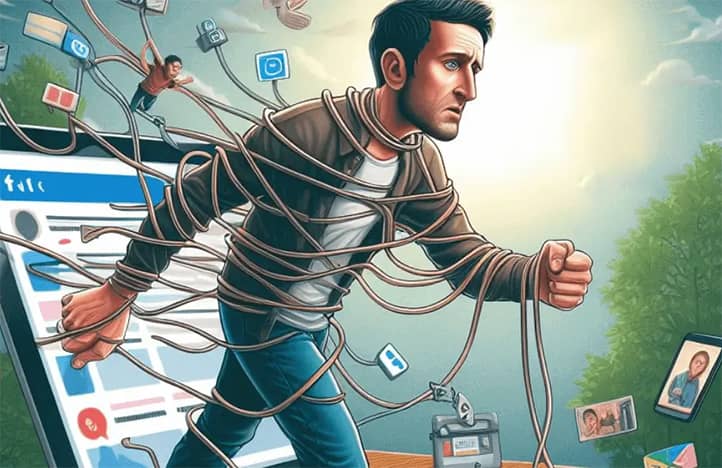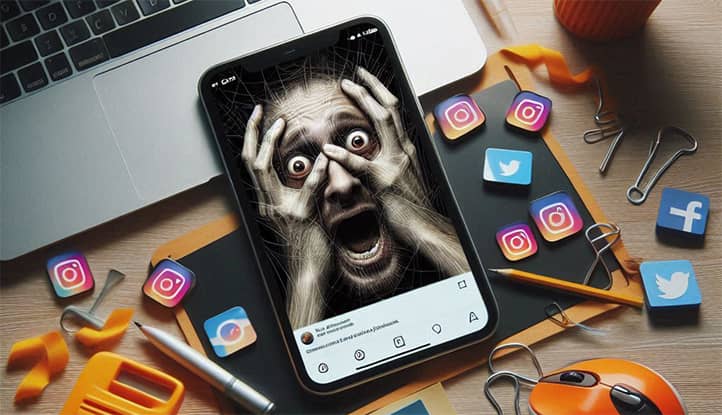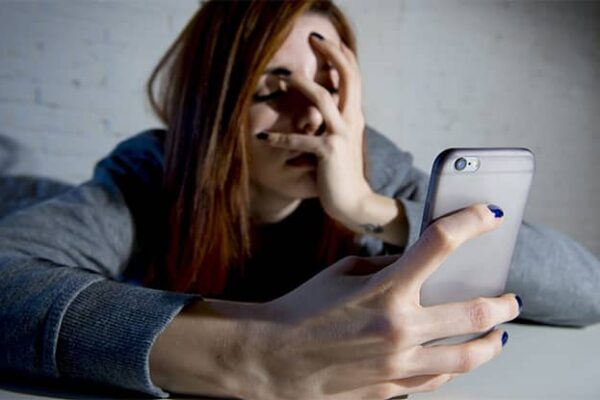Social networks and digital technologies have become an integral part of our lives, shaping a new style of communication, self-expression, and social interaction while influencing our worldview, self-esteem, and mental health. One intriguing yet alarming phenomenon in this context is the similarity between compulsive social media use and obsessive-compulsive disorder (OCD).

Obsessive-Compulsive Disorder: Definition and Key Manifestations
Obsessive-compulsive disorder (OCD) is a mental disorder characterized by persistent obsessive thoughts (obsessions) and repeated actions (compulsions) performed to reduce anxiety. Key manifestations of obsessions include thoughts about contamination, fear of losing control, the need for order and symmetry, fear of causing harm, and other irrational worries. Compulsions, in turn, are expressed in actions that individuals feel compelled to perform repeatedly (such as hand washing, checking locked doors, or arranging items) to temporarily relieve their anxiety.
OCD complexly impacts a person’s life, keeping them in a state of constant worry and preoccupation with their rituals. This disorder significantly affects daily life, limits freedom of choice, and reduces quality of life. On the surface, social networks seem far removed from such manifestations, yet the digital environment creates specific conditions that can lead to similar traits and rituals.
The Digital Environment and the Formation of Compulsive Behavior
With the advent and development of social networks, we have encountered a new culture where personal and public boundaries become blurred. “Life on display” has become the norm, from sharing personal milestones to posting daily updates. People now strive to create an idealized image that reflects societal standards of beauty, success, and appeal. Social networks such as Instagram, Facebook, and TikTok provide a constant stream of information that stimulates the desire for attention, approval, and support.
This desire often manifests in the form of a need to regularly check and update posts, likes, and comments. Rituals like frequently checking notifications and assessing follower reactions create an illusion of social approval that temporarily reduces anxiety but requires constant repetition. This mirrors the OCD mechanism: initially, a person feels anxiety (did they receive a negative comment? how many likes?), then performs an action to relieve it (checking, editing), and the anxiety subsides only temporarily, returning soon after.
Do Social Networks Contribute to Developing Obsessive-Compulsive Disorder?
Social networks are often geared toward keeping users engaged and, in essence, encourage compulsive behavior. The constant accessibility of smartphones and digital platforms makes it easy for users to engage in actions aimed at managing their digital personas. This raises the question: can social networks truly act as a trigger, reinforcing obsessive traits?
The pursuit of approval and the desire to be liked has become a new digital obsession, while repetitive rituals (such as regularly updating profiles or perfecting every detail of a post) become a compulsion. Over time, these habits may solidify, creating discomfort and a constant need for validation similar to that seen in OCD.

Signs of Obsessive Behavior in Social Networks
Social networks promote certain forms of behavior that may resemble obsessive-compulsive disorder, even if users themselves are unaware. From constantly checking notifications to an endless quest for the “perfect” post—these actions intensify feelings of anxiety and the desire for approval. Below are the main signs of obsessive behavior observable on social networks.
Constantly Checking Notifications and Updates
One of the clearest signs of obsessive behavior is the urge to constantly check notifications and updates. Messages, likes, comments, story views—all of these can provoke anxiety if a person does not see activity in their profile for an extended period. Such users may feel significant distress if their posts do not receive the expected response. This leads to cyclical behavior: anxiety → checking → temporary relief → renewed anxiety when attention fades.
Key signs of obsessive behavior in checking notifications:
- Anxiety and unease if there are no new likes or comments for a long time
- Worry when there are no notifications, feeling that something has been missed
- Habit of checking the account every few minutes to view new reactions
Compulsive Striving for Perfection in Posts
Many people aim to create an appealing digital persona by spending hours choosing the perfect photos, editing text, and thinking about how the post looks in the feed. This quest for the “perfect” post reflects obsessive behavior: users cannot simply post a photo or thought without making it “just right.” This often leads to posts being delayed or endlessly edited until they feel “good enough.”
This includes the following aspects:
- Endless work on a single post: changing photos, rephrasing text, adding and removing hashtags
- Using numerous filters and editing tools to give photos the “perfect look”
- Carefully considering each element of the post and how it appears in the overall feed
Anxiety Over Likes and Follower Counts
In the digital world, likes and follower numbers become metrics of approval. People with obsessive traits may start to depend on these metrics, experiencing significant anxiety if a post does not receive enough likes or if their follower count decreases. The drive to maintain a high level of approval creates a closed loop, where each new like brings temporary relief, but soon anxiety returns if engagement drops.
This is expressed in:
- Worrying about the number of likes, especially if they are lower than expected
- Constantly checking follower counts and reactions to new posts
- Feeling that likes and followers reflect personal worth and success
Repetitive Actions: Posting and Updating Cycles
Many social media users engage in rituals and repetitive actions aimed at maintaining an attractive profile. These actions create an illusion of control and order, which temporarily relieves anxiety related to approval. People may begin to repeat certain actions in a strict order, for instance, posting at the same time each day, checking likes and comments multiple times in a row, or rephrasing comments to ensure they “sound right.”
This includes several characteristic rituals:
- Checking the account at specific times of day (for example, every morning and evening)
- Refreshing the page or app in hopes of seeing new notifications
- Setting a posting schedule to increase likes and reach
All these signs indicate that social media use can evolve into obsessive and compulsive behavior similar to OCD symptoms. When digital activity becomes a way to relieve anxiety and maintain a sense of control, individuals may find themselves trapped in repetitive actions and “digital perfectionism.”

Influence on Self-Esteem and Mental Health
Obsessive behavior on social media significantly impacts users’ mental state and self-esteem, creating a vicious cycle of negative experiences. The pursuit of an “ideal” image, dependence on the number of likes and followers, and constant comparison with others can lead to various forms of stress and anxiety, diminish self-confidence, and intensify obsessive-compulsive traits.
Decreased Self-Esteem and Feelings of Inadequacy
Social media often portrays idealized images, where users post only the best moments of their lives, creating an illusion of perfection. Those who spend a lot of time viewing such posts begin to feel a sense of inadequacy. Constant comparisons push them to believe their life or appearance is far inferior.
This leads to:
- Discontent with their own appearance, especially when comparing themselves to “perfect” photos.
- Feelings that their achievements are insignificant compared to others’ “successes.”
- A need to meet high standards, which heightens anxiety and dissatisfaction.
Furthermore, the impression that everyone else is living a more successful and fulfilling life reduces self-confidence and compels people to constantly seek external validation of their worth.
Dependence on Approval and the Digital “Recognition Trap”
When users post, they often anticipate a positive response, and if that doesn’t happen, their self-esteem may suffer. Receiving likes and comments provides a brief sense of satisfaction and validation, but it quickly fades, leading to a new cycle of anxiety and a desire to “earn” more reactions.
This becomes the so-called “recognition trap,” where people start posting content not out of personal interest but for others’ reactions. Gradually, approval becomes the only source of confirmation of their self-worth.
Signs of dependency on approval:
- Strong anxiety when there is no reaction to a post.
- Reluctance to delete unsuccessful posts, even if they cause discomfort, out of fear of missing potential likes.
- Feelings of insecurity and lowered self-esteem with a low number of likes.
Development of Anxiety and Depressive Symptoms
When self-esteem and a sense of significance depend on reactions on social media, the risk of developing anxiety and depressive symptoms increases. People begin to feel anxious before each post, worrying about how followers will perceive it. If the post doesn’t receive the expected attention, feelings of shame or even social isolation may arise. These experiences can escalate into significant emotional stress, contributing to the development of depressive symptoms, especially if ignored for long.
Anxiety and depressive symptoms associated with obsessive behavior on social media:
- Feelings of disappointment and sadness after a post fails to gain enough attention.
- Excessive anxiety before posting, along with the feeling that it must be perfect.
- Constant worry about potential negative comments or lack of likes.
Loss of Personal Identity and Striving for a “Digital Ideal”
Over time, social media users may feel that their real selves do not align with the online image they have created, and they strive to maintain only this “digital ideal.” This process can have a destructive effect on personality and self-esteem, as individuals stop accepting and respecting their true qualities, adapting to others’ expectations instead.
This can result in obsessive thoughts and actions focused on maintaining an online persona that no longer reflects their real selves. Constant attempts to achieve a digital “ideal” generate inner conflict, heightening anxiety and feelings of inadequacy, which lowers self-esteem and leads to a loss of inner balance.
Vicious Cycle of Obsessive Behavior and Worsening Mental State
The mechanisms described above create a vicious cycle that is difficult to escape. As a result, individuals are constantly under the influence of external evaluations, developing a dependency on approval and anxiety before any post. This leads to a worsening mental state with symptoms of obsessive-compulsive disorder. Constant anxiety and depression become companions for those whose self-esteem and personal values are based on digital reactions.

The Phenomenon of “Digital Perfectionism” and Its Similarity to OCD
With the development of social networks and the growing popularity of digital platforms, the phenomenon of “digital perfectionism” has become a noticeable trait of internet culture. This phenomenon is expressed as the desire to present one’s online image as perfectly as possible, with “polished” posts. People spend significant time perfecting every detail, from selecting photos to editing text and processing images. This pursuit of perfection often takes on obsessive qualities, drawing parallels to obsessive-compulsive disorder (OCD).
Obsessive Striving for Perfect Content
Digital perfectionism begins with the desire to make posts look perfect. This quest for perfection manifests in obsessive actions aimed at creating the ideal post. Some users spend excessive time choosing images, editing text, and crafting a visually appealing profile. In the pursuit of “perfection,” they may spend hours on a single post, revisiting and correcting even minor details.
The similarity to OCD here is that each action becomes ritualized and repetitive. Those with digital perfectionism experience temporary satisfaction from their post, similar to the relief experienced by people with OCD when performing rituals. However, this feeling soon fades, and the desire to create even more perfect content reignites, triggering a new cycle of obsessions.
Constant Self-Criticism and Fear of “Inadequacy”
One of the main aspects of digital perfectionism is constant self-criticism. Social media users fear that their posts do not meet the high standards they themselves have set. This fear of “inadequacy” is expressed in the obsessive desire to correct every detail of a post so it looks “perfect” for the audience. Even minor mistakes, such as typos or awkward photo angles, can cause anxiety and embarrassment.
These traits resemble OCD symptoms, where individuals feel anxious if they can’t achieve “perfection” in their actions. In digital perfectionism, people seek to avoid any “imperfections,” experiencing acute worry if a post does not elicit the desired response. As a result, they may delete or edit posts repeatedly to eliminate all possible “flaws.”
Dependency on “Likes” and External Approval
Digital perfectionism is also linked to a dependency on others’ approval. For people striving for perfection on social media, each like or comment notification becomes a form of “confirmation” of their success. The more likes and positive feedback, the higher the temporary sense of satisfaction. However, similar to OCD, this feeling does not last long. People begin to feel anxious if the number of likes falls short of expectations and return to creating new, even more “perfect” content.
Signs of dependency on external approval, similar to OCD:
- Constantly checking the number of likes and comments after posting.
- Significant anxiety if audience response doesn’t meet expectations.
- Feeling that personal significance depends on the number of reactions to a post.
Rituals and Repetitive Actions to Maintain the Ideal Image
Like OCD, digital perfectionism often includes ritualistic and repetitive actions. Social media users may establish strict rules and routines for creating “perfect” content, and any deviations from these rituals can cause anxiety. For example, many pay attention to posting times, believing that posting at a specific hour will increase views. Rituals may also involve choosing themes or styles that the person believes to be “lucky” or “successful.”
These rituals can be compared to compulsions observed in individuals with OCD. Performing these rituals provides temporary relief, but if a person deviates from their usual routine, they experience anxiety, irritation, and stress.
Digital Perfectionism and the Formation of Obsessive Thoughts
Obsessive thoughts, characteristic of OCD, can also manifest in digital perfectionism. In this case, the obsession lies in the thought that every post must be perfect, or reputation or social status will suffer. These thoughts compel individuals to repeatedly return to the content of their posts, editing and checking, which is reminiscent of obsessions in people with OCD.
In digital perfectionism, such obsessive thoughts may include:
- Fear of being judged for the slightest mistake in a post.
- Belief that a post with fewer likes or comments reduces their status.
- Compulsive worry that a post must align with the latest trends and audience expectations.
Time Expenditure and Emotional Burnout
Digital perfectionism demands significant time and emotional resources. Preparing and editing posts, checking notifications, tracking trends, and caring for one’s digital image occupy so much time that users often sacrifice other aspects of life, such as rest, communication, or work. This behavior not only reflects obsessive thoughts and actions but can also lead to severe emotional burnout.
These time and energy costs are reminiscent of the experiences of people with OCD, whose rituals occupy a significant part of their day. Just as in OCD, the refusal to perform these actions causes great anxiety, so digital perfectionists become increasingly drawn into the process. Over time, this can lead to feelings of loneliness, isolation, and, consequently, depression.
Digital perfectionism in social media, although not a clinical form of OCD, shares many similar traits, including ritualistic actions, obsessive thoughts, dependency on external approval, and a constant quest for perfection. Understanding these similarities can help better recognize the risks and impact of social media on mental health and take timely measures to minimize negative consequences.

Social Networks as a Factor in Worsening OCD Symptoms
Modern social networks offer users limitless opportunities for sharing information, self-expression, and communication. However, for individuals with obsessive-compulsive disorder (OCD), these platforms can become an environment that exacerbates symptoms. The constant stream of visual and textual content, the need to evaluate and engage with others’ posts, and the expectation of external validation can act as triggers that intensify obsessive thoughts and compulsive behaviors.
Intensification of Obsessions through Comparisons with Others
One key factor in the worsening of OCD symptoms on social media is the tendency of users to compare themselves with others. For those with OCD, this comparison can become painfully obsessive, especially when idealized images and “perfect” profiles are involved. Such comparisons lead to feelings of inadequacy, anxiety, and a drive to “measure up,” potentially fueling obsessive thoughts.
Key Triggers that Amplify Obsessions:
- Viewing profiles of people with perfectly edited photos
- Frequent posts about achievements that the user feels are unattainable
- Content with high standards, creating a sense of “not measuring up”
These triggers provoke obsessive thoughts, where users start perceiving themselves as less successful or attractive. For individuals with OCD, this exacerbates their condition by intensifying fears and doubts related to self-esteem and social expectations.
Constant Expectation of Approval: Dependence on Likes and Comments
For many social media users, the number of likes and comments serves as an indicator of their worth and success. However, for individuals with OCD, this external validation becomes so crucial that it starts to control their behavior and emotional state. They become dependent on this approval, and its absence triggers anxiety and a compulsive urge to modify content.
Manifestations of Approval Dependence in OCD:
- Frequent checking of likes and comments after posting
- Feeling anxious or dissatisfied with a lack of reactions
- Compulsive need to delete and repost if approval expectations are not met
In this way, social networks sustain a vicious cycle: the user posts content, hoping for positive feedback, and when it doesn’t come, their self-esteem drops, leading to more compulsive actions and further symptom worsening.
Availability of “Negative” Triggers
Social networks are filled with various types of content, including elements that may worsen the condition of individuals with OCD. These can range from alarming news to unpleasant comments or others’ negative experiences. Such triggers provoke waves of obsessions and compulsions as users experience heightened anxiety and fear for their own well-being.
Triggers that Exacerbate Symptoms:
- News about negative events or disasters
- Explicit or aggressive comments on posts
- Content that raises concerns about health, appearance, or safety
These factors can prompt rituals and repetitive actions aimed at reducing anxiety. Individuals with OCD may repeatedly check news feeds, block negative users, or browse profiles to “calm themselves down.”
Frustrating Feeling of “Missed Opportunities”
Social networks often create the illusion that others live more vibrant and fulfilling lives. This perception is intensified for individuals with OCD, who tend to pay special attention to details and attribute significance where there may be none. Posts highlighting others’ successes, travels, or achievements can provoke feelings of envy and obsessive thoughts about missed opportunities.
This obsession is reinforced by each post that reminds them they are supposedly living “the wrong life.” Constant ruminations about “missed opportunities” initiate a new cycle of obsessive thoughts and compulsive actions, such as reviewing old posts or modifying content to present themselves more favorably.
With their constant flow of information, the possibility of ratings, and the competition for attention, social networks become a sort of “nutrient medium” for people with obsessive-compulsive disorder. Unlike in everyday life, where external triggers can be limited, social networks easily provoke OCD symptoms, intensifying obsessive thoughts, ritualistic behaviors, and emotional exhaustion.

Strategies for Overcoming Obsessive Behavior Online
Obsessive behavior on social networks becomes a serious issue for individuals with OCD, as it contributes to increased anxiety and loss of control. To mitigate the negative impact of this phenomenon, it is crucial to implement effective strategies for mindful management of one’s time and online activity. Below are various approaches and techniques that can help individuals with obsessive behavior find balance and improve their mental health.
Setting Time Limits on Social Media Use
One of the first and simplest steps to overcome obsessive behavior online is to limit time spent on social media. People with OCD are encouraged to set specific time frames for using these platforms to reduce the risk of obsessions and compulsions associated with content checking.
Helpful Recommendations:
- Determine how much time per day you can dedicate to social media, and stick to this limit.
- Use apps that block access to social networks after the designated time is up.
- Schedule regular breaks from digital spaces to prevent psychological exhaustion.
By consistently adhering to these limits, one can gradually become accustomed to spending less time online and improve self-control.
Transition to Mindful Social Media Use
Mindful use of social networks helps reduce the impact of obsessive thoughts and anxieties triggered by compulsive comparisons with others or dependency on approval. Mindfulness involves staying in the moment and controlling one’s actions, avoiding automatic immersion in news feeds or constant notification checks.
Strategies for a Mindful Approach:
- Clearly define your purpose for using social media before logging in: Do you want to catch up on news, socialize, or find inspiration?
- Notice your thoughts and feelings while viewing content — pay attention to moments when anxiety or the desire to compare yourself with others arises.
- Turn off unnecessary notifications to reduce distractions.
This approach not only decreases the time spent on social media but also improves its quality by reducing negative emotions.
Focusing on Real Achievements Instead of Virtual Ones
Another key step to overcoming obsessive behavior is shifting focus from virtual achievements to real-life accomplishments. Individuals with OCD may feel compelled to constantly post and track their successes online, leading to an excessive dependency on virtual approval. Focusing on real goals and tasks helps reduce this dependency and brings a sense of fulfillment to daily life.
Techniques for Shifting Focus:
- Record your accomplishments in a journal or notes app instead of sharing them on social media.
- Develop plans for achieving personal and professional goals that don’t involve digital spaces.
- Create a list of tasks that bring satisfaction without needing to be posted for validation.
This approach helps build confidence and satisfaction without needing external confirmation, which is especially important for those prone to OCD.
Addressing Cognitive Distortions
Many obsessive thoughts on social media are linked to cognitive distortions, where individuals perceive information in a distorted way. For instance, believing that others’ “perfect” photos and posts fully reflect their lives. Recognizing these distortions helps lower anxiety levels and reduce obsessive tendencies.
Addressing Common Cognitive Distortions:
- Personalization: Viewing every negative comment as personal criticism. Remember, it may not relate to you.
- Mind-reading: Believing others always judge your posts or actions negatively.
- Catastrophizing: Expecting the worst if a post doesn’t receive enough likes.
Using cognitive restructuring techniques helps perceive information more objectively and avoid obsessive interpretations.
Support and Counseling from Specialists
For many individuals with obsessive behavior on social media, support from a psychologist or psychotherapist can be invaluable. Professionals can help identify triggers leading to obsessions and develop strategies to overcome them. Cognitive-behavioral therapy (CBT) is considered one of the most effective approaches for working with OCD.
Benefits of Consulting a Psychologist:
- A chance to discuss experiences and identify their origins
- Working on building healthy habits and avoiding harmful patterns
- Support during symptom exacerbations and assistance with managing emotional states
For individuals with OCD, regular consultations provide support and allow progress in changing habits and thinking.
Incorporating “Digital Detox Days”
Digital detox is a practice of completely refraining from social media use for a specific period. This technique helps to break free from the pressures of the virtual world, strengthen internal boundaries, and restore emotional balance. For individuals with OCD, “digital detox days” can help manage compulsive habits and reduce anxiety.
Tips for Conducting a Digital Detox:
- Plan weekends or evenings that exclude social media usage.
- Find alternative activities that bring enjoyment and distract from the urge to check social media.
- Gradually increase time spent without social media to build a sustainable habit.
This practice reduces social media’s impact on mental health and strengthens the ability to use virtual space mindfully.
By applying these strategies, people with obsessive-compulsive disorder can lessen the influence of social networks on their behavior and mental health, improve control over their actions, and reduce anxiety.

Conclusion
In today’s digital age, where social networks have become ingrained in daily life, their impact on mental health and behavior is increasingly evident. For individuals prone to obsessive-compulsive tendencies, social networks can become a source of constant stress and intensified obsessive thoughts. As shown in the analysis in this article, presence in the virtual space fosters the intensification of obsessive behaviors and even the development of new forms of obsessiveness, such as “digital perfectionism.” These phenomena demand serious attention and a conscious approach to social media use.
An important takeaway is that to control obsessive behavior, it’s essential to recognize its signs promptly. Constantly refreshing news feeds, compulsively checking notifications, and craving likes and approval from other users — all indicate a growing psychological dependence on social networks.




